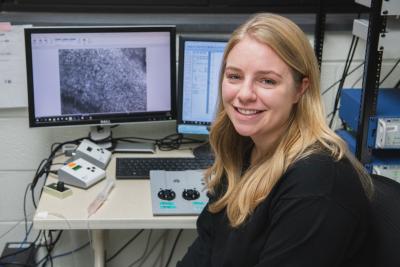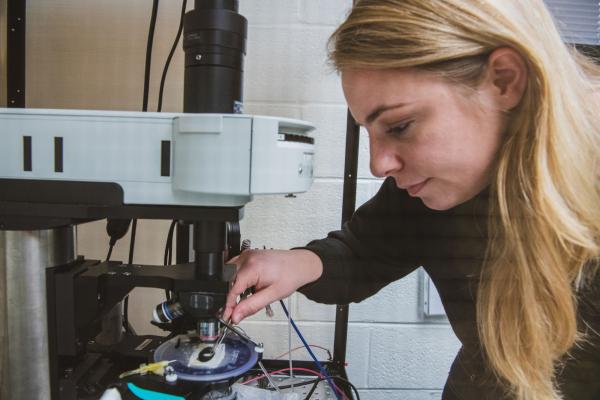
Postdoctoral fellow Laurel Seemiller works in the lab of Nikki Crowley, where she studies the biology of adolescent alcohol usage and its long-term consequences. She is a graduate of the Molecular, Cellular, and Integrative Biosciences (MCIBS) Intercollege Graduate Degree Program in the Penn State Huck Institutes of the Life Sciences. We chatted with Seemiller about her research and her experience at Penn State.
How did you come to study neuroscience?
I have a background in biology, but I have always been interested in behavior and the biological systems that govern behavior. I did my Ph.D. research in behavioral genetics with Thomas Gould in the College of Health and Human Development through the MCIBS program at Penn State. Now that I am a part of Nikki’s research group, I focus a bit more on cellular biology and neural circuits, which bridges the gap between genetics and behavior.
What is the focus of your research?
I am interested in characterizing exactly how adolescent alcohol use can promote addiction-relevant behaviors later in life, and in figuring out the underlying biology. We use a mouse model system to look at a region of the brain called the prefrontal cortex, specifically a subregion that is broadly vulnerable and the last region to develop in the brain. We use a variety of techniques to explore a population of neurons in this region that can be dysregulated with alcohol use. If we can clarify the mechanisms at play, we may eventually be able to target these neurons with a pharmacological intervention to prevent or treat long-term consequences of adolescent alcohol use. By looking for predictors of later deficits, we may also be able to identify markers for early detection of addiction-related vulnerabilities.
What kinds of techniques do you use?
We use a combination of techniques that range from behavioral tests to brain imaging. Using a method called patch clamp electrophysiology, we can look at specific neurons in the brain tissue of mice that have been exposed to alcohol in order to characterize the changes in the connections between neurons, called synapses. I am also working with faculty in other departments to image the brain while mice are performing behaviors and to get a different look at the brain using magnetic resonance imaging (MRI).

Who else do you work with in your research?
I have been working closely with a recent graduate of the Neuroscience Ph.D. program, Avery Sicher, on this project, and we have four undergraduates who help us collect data. I love working with undergrads; it’s a great way to ground yourself in the applications of what we’re doing and reexperience the excitement of learning these things from the beginning.
I also enjoy learning from other members of the Neuroscience Institute, which has been really enthusiastic about supporting trainees. I cofounded a journal club with another postdoc, where postdocs, grad students, techs, and undergraduates in neuroscience labs can come together and read the latest scientific papers and build a sense of community.
What’s next for you?
I recently received a fellowship from the National Institute on Alcohol Abuse and Alcoholism of the US National Institutes of Health (NIH) that allows me to work on projects like this one. I am applying for another NIH grant that will hopefully me set up a more independent line of research. This is something I would hope to take with me to an academic position, where I could pursue research and teaching. Thanks to this federal funding, we can really come to understand the mechanisms of alcohol use disorders and help mitigate the consequences.
